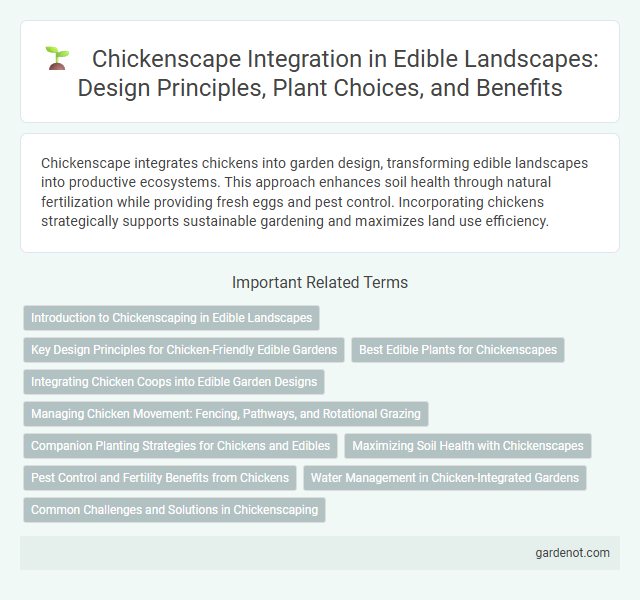Chickenscape integrates chickens into garden design, transforming edible landscapes into productive ecosystems. This approach enhances soil health through natural fertilization while providing fresh eggs and pest control. Incorporating chickens strategically supports sustainable gardening and maximizes land use efficiency.
Introduction to Chickenscaping in Edible Landscapes
Chickenscaping integrates poultry into edible landscapes, enhancing garden productivity and soil health through natural foraging and fertilization. This sustainable approach allows chickens to control pests and weeds while providing fresh eggs, creating a symbiotic environment that supports plant growth and biodiversity. Designing a chickenscape requires careful planning of nesting areas, foraging zones, and protective shelters to optimize both chicken welfare and edible yield.
Key Design Principles for Chicken-Friendly Edible Gardens
Chickenscape design integrates secure, shaded areas with robust fencing to protect chickens while allowing natural foraging. Incorporating diverse, edible plants like herbs, berries, and leafy greens supports chickens' nutrition and encourages beneficial pest control. Rotational grazing zones maintain soil health and prevent overgrazing, promoting sustainable, productive edible landscapes.
Best Edible Plants for Chickenscapes
Chickenscapes thrive with nutrient-rich edible plants such as comfrey, kale, and clover, which provide essential vitamins and minerals for healthy chickens. Incorporating herbs like basil, mint, and thyme enhances poultry immunity and deters pests naturally. Fast-growing grains such as oats and barley supply energy, promote foraging behavior, and improve overall flock vitality.
Integrating Chicken Coops into Edible Garden Designs
Chickenscape seamlessly integrates chicken coops into edible garden designs, offering a sustainable source of fresh eggs while enhancing soil fertility through natural fertilization. Strategic placement of coops among raised beds and fruit trees maximizes space efficiency and promotes biodiversity. This approach supports eco-friendly pest control, reducing the need for chemical interventions in edible landscapes.
Managing Chicken Movement: Fencing, Pathways, and Rotational Grazing
Managing chicken movement within a Chickenscape involves installing secure, predator-proof fencing to contain flocks and protect plants. Designing dedicated pathways minimizes soil compaction and prevents damage to edible crops, allowing chickens to forage efficiently. Implementing rotational grazing cycles distributes manure evenly and promotes soil health while reducing pest buildup.
Companion Planting Strategies for Chickens and Edibles
Chickenscape integrates companion planting strategies by selecting plants that deter pests and enrich soil, benefiting both chickens and edible crops. Herbs like oregano and thyme repel insects while providing chickens with natural foraging options. Combining nitrogen-fixing legumes with vegetables enhances soil fertility, supporting healthy plant growth and sustainable chicken habitats.
Maximizing Soil Health with Chickenscapes
Chickenscapes enhance soil health by integrating poultry into edible landscapes, promoting natural fertilization through nutrient-rich manure that improves soil organic matter. The chickens' scratching behavior aerates the soil, increasing microbial activity and nutrient cycling essential for robust plant growth. This sustainable approach reduces reliance on chemical fertilizers, fostering a balanced ecosystem that supports healthier crops and long-term soil vitality.
Pest Control and Fertility Benefits from Chickens
Chickenscape integrates chickens into edible landscapes to naturally control pests, as chickens forage for insects, larvae, and ticks, reducing the need for chemical pesticides. Their scratching behavior aerates the soil, promoting microbial activity and enhancing nutrient cycling, which improves soil fertility. Manure from chickens acts as a rich organic fertilizer, supplying essential nitrogen, phosphorus, and potassium that boost plant growth and yield.
Water Management in Chicken-Integrated Gardens
Chickenscapes enhance water management by naturally distributing water through soil aeration from chicken scratching and foraging behaviors. This integrated approach reduces soil compaction, improves water infiltration, and minimizes runoff, promoting healthier plant growth and sustainable irrigation. Utilizing chickens in edible landscapes creates a self-sustaining water cycle that supports both poultry and garden ecosystems.
Common Challenges and Solutions in Chickenscaping
Chickenscaping often faces challenges such as plant damage from scratching and foraging behaviors, predator threats, and maintaining soil health under constant hen activity. Remedies include selecting robust, pest-resistant plants, installing secure fencing or predator deterrents, and implementing rotational grazing to allow soil and vegetation recovery. Integrating mulch and compost can further enhance soil structure while minimizing erosion caused by chicken movement.
Chickenscape Infographic

 gardenot.com
gardenot.com